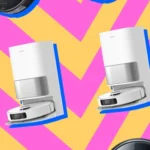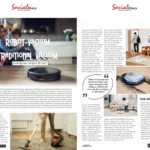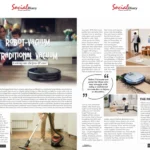The world is constantly evolving and so are our cleaning habits. With the advent of technology, traditional cleaning methods have been replaced with automated devices. Smart vacuum cleaners are a prime example of this change. They come in many forms, each with their unique features. One of the most significant differentiating factors is whether the model is self-emptying or non-self-emptying. The question that arises is, which one is better? In this article, we will delve into a comparison of these two types of vacuum cleaners and explore their distinct advantages and disadvantages. By the end, you’ll have a clear idea of which type is right for your needs.
What Is a Self-Emptying Vacuum Cleaner?
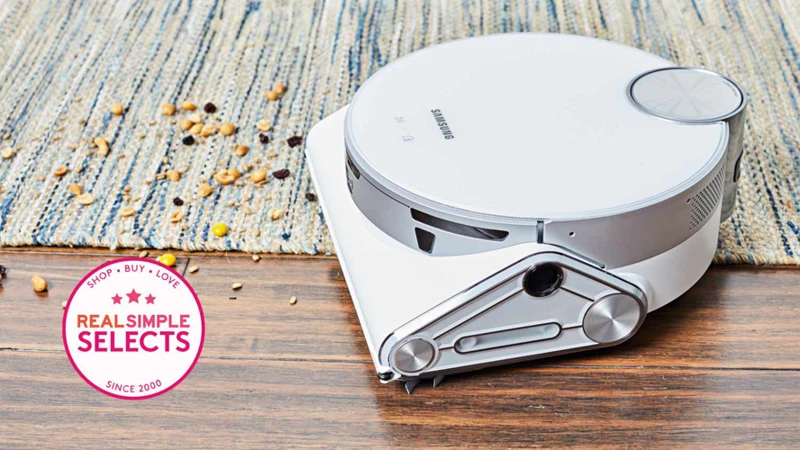
A self-emptying vacuum cleaner is a smart and efficient device that is designed to automate the vacuuming process. It is basically a robot vacuum cleaner that can clean your home without any human assistance. The most notable feature of a self-emptying vacuum cleaner is that it can empty itself automatically into a dustbin or dirt container. This means that you don’t have to keep an eye on the vacuum’s dustbin and empty it manually, saving you plenty of time and effort.
How It Works
Self-emptying vacuum cleaners work just like any other robot vacuum cleaner, but with an added feature of an automatic dirt disposal system. These vacuum cleaners are equipped with a charging dock that doubles up as a self-emptying station. After cleaning your home, the vacuum cleaner returns to the dock where it connects to the self-emptying station, which sucks out all the collected dirt and debris from the dustbin of the vacuum cleaner. The dirt and debris are collected in a separate bag or container, which can be removed and disposed of when full.
Pros
One of the biggest advantages of a self-emptying vacuum cleaner is the convenience it offers. You don’t have to worry about constantly emptying the dustbin manually, which can be a time-consuming and messy task. Another advantage of a self-emptying vacuum cleaner is the capacity of the disposal bag or container, which is much larger than that of traditional vacuum cleaners. This means you can go longer without having to empty the bag or container.
Cons
One of the downsides of a self-emptying vacuum cleaner is the noise it produces. Because the vacuum cleaner needs to connect to the charging station and the self-emptying station, it can produce more noise than a traditional vacuum cleaner. Additionally, self-emptying vacuum cleaners tend to be more expensive than traditional vacuum cleaners, largely due to their advanced features.
Self-emptying vacuum cleaners are a great option for those looking to automate their cleaning process and save time. While they can be pricier and noisier than non-self-emptying models, the convenience they offer may be well worth the investment.
How It Works
How Self-Emptying Vacuum Cleaner Works
Self-emptying vacuum cleaners work by using a dock or base station that the vacuum cleaner returns to after it completes a cleaning cycle. The base station contains a dustbin or debris bag that is connected to the vacuum cleaner.
Once the vacuum cleaner docks with the station, the base station will automatically empty the dustbin or shake the debris bag, which will transfer the collected debris into a larger disposable bag. This means that the vacuum cleaner is ready for the next cleaning session and doesn’t require constant manual maintenance.
Some self-emptying vacuum cleaners have more advanced features that allow the disposable bag to hold up to 30 days’ worth of dirt, dust, and debris. This ensures that users won’t need to empty the bag frequently and can instead dispose of the bag only once a month.
It’s worth noting that not all self-emptying vacuum cleaners work in the same way. Some models use an internal dustbin where the collected debris is packed into a smaller disposable bag that can then be emptied by the user. Others use a canister that is completely sealed and can be disposed of without the user even having to touch it.
How Non-Self-Emptying Vacuum Cleaner Works
Non-self-emptying vacuum cleaners work by using a dustbin or debris bag that is included in the vacuum cleaner itself. Once the dustbin or bag is full, the user must empty it manually by removing it from the vacuum cleaner and disposing of the contents.
This can be a messy and time-consuming process, especially if the user has to empty the dustbin frequently if they have pets that shed excessively or if the vacuum cleaner doesn’t have a large capacity.
However, some non-self-emptying vacuum cleaners come with more advanced features that make the process easier. For example, some models have a dustbin that is easy to disassemble and clean, and some come with a motorized brush that can help loosen any debris stuck on the brush roll.
While non-self-emptying vacuum cleaners require more manual maintenance than their self-emptying counterparts, they still perform an excellent job of cleaning floors, carpets, and upholstery.
Bagged vs. Bagless Smart Vacuum Comparison
Pros
When it comes to the pros of self-emptying vacuum cleaners, the first and foremost advantage is their convenience. These smart vacuums are designed to do most of the work for you, making them ideal for busy individuals who don’t have the time or energy to clean their homes regularly. The self-emptying feature eliminates the need to empty the dustbin manually after each cleaning session, thereby saving time and hassle.
Another advantage of self-emptying models is that they often have larger dustbin capacities than their non-self-emptying counterparts. This means you can go longer without needing to empty the bin, which in turn reduces the amount of time you need to spend maintaining your vacuum.
Additionally, self-emptying models come with high-tech features that aren’t available on non-self-emptying versions. Many of these vacuums come with advanced mapping technology that allows them to navigate your home more efficiently and avoid obstacles. Some models can even be controlled via an app on your smartphone, which makes it easier to schedule cleaning sessions and customize your cleaning preferences.
Last but not least, self-emptying vacuums often have superior filtration systems compared to non-self-emptying models. Many of these vacuums come equipped with HEPA filters, which are capable of trapping even the smallest allergens and dust particles, making them ideal for those with allergies or pets. For more information about filters, you can check our in-depth article “Filter Systems Compared: HEPA vs Standard Filters in Smart Vacuum Cleaners”.
The convenience, larger dustbin capacity, advanced features, and superior filtration systems are all significant advantages of self-emptying vacuum cleaners. However, they do come with a higher price tag and noise level compared to non-self-emptying models, which are factors to consider before making a purchase. Check out our comparison articles on “Most Powerful Smart Vacuum Cleaners”, “Smart Vacuum Pet Hair Comparison”, “Noise Levels in Smart Vacuum Cleaners”, “Smart Vacuum Battery Life Comparison”, and “Smart Vacuum Cleaners Mopping Comparison” to help you make a more informed decision.
Cons
When it comes to self-emptying vacuum cleaners, there are some potential drawbacks to consider. One of the biggest downsides is the cost. Self-emptying vacuum cleaners tend to be more expensive than their non-self-emptying counterparts. This can be a significant investment for many households, especially if you’re on a tight budget.
In addition to the cost, self-emptying vacuum cleaners can also be a bit noisy. The vacuum’s motor is powerful and can produce a buzzing sound while it’s in operation. This can be annoying if you’re trying to watch TV or have a conversation while the vacuum cleaner is running.
Another potential downside is the need for regular maintenance. While self-emptying vacuum cleaners do offer a higher level of convenience, they also require more attention to keep them functioning properly. The vacuum’s dustbin needs to be emptied regularly, and the filters need to be cleaned or replaced periodically. If you neglect these tasks, the vacuum’s performance may suffer, and you’ll end up with a dusty home.
Lastly, self-emptying vacuum cleaners tend to have a smaller capacity than non-self-emptying models. This means you’ll need to empty the dustbin more frequently, which can be a hassle. If you have a large home or have pets that shed a lot, you may find yourself emptying the bin multiple times during each cleaning session.
All in all, while self-emptying vacuum cleaners are convenient and offer a unique set of benefits, they do come with some potential downsides to consider before making a purchase. Be sure to weigh the pros and cons carefully to determine if a self-emptying model is right for you and your household’s cleaning needs.
What Is a Non-Self-Emptying Vacuum Cleaner?
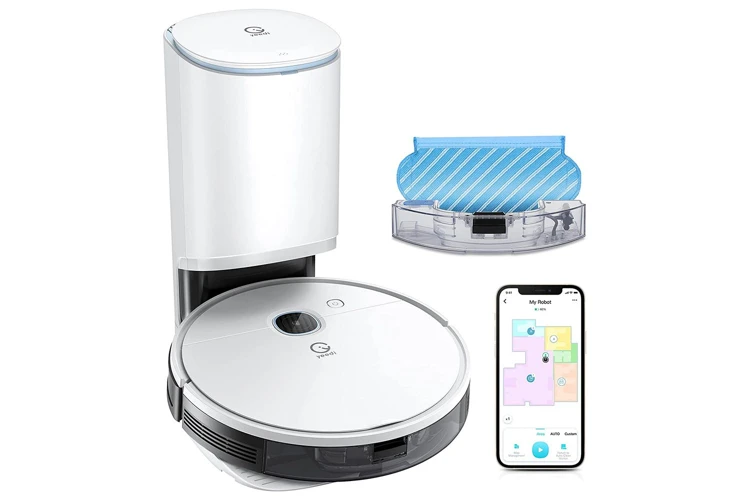
Unlike self-emptying vacuum cleaners, non-self-emptying models require you to manually empty the dustbin. These models come in various shapes, sizes, and types, including handheld, stick, and upright vacuum cleaners.
How It Works
Non-self-emptying vacuum cleaners suck up dirt and debris into a dustbin that is attached to the machine. The dustbin needs to be manually emptied once it reaches its maximum capacity. To do this, you need to detach the dustbin from the vacuum cleaner and empty it into a trash can. Non-self-emptying vacuum cleaners typically come with a filter that needs to be cleaned or replaced on a regular basis to maintain optimal performance.
Pros
One advantage of non-self-emptying vacuum cleaners is their lower price point compared to self-emptying models. They are typically more affordable and budget-friendly, making them accessible to a wider range of consumers. Additionally, non-self-emptying vacuum cleaners offer more versatility in terms of the types of surfaces they can clean, as they come in various shapes and sizes.
Cons
The main downside of non-self-emptying vacuum cleaners is the inconvenience of having to manually empty the dustbin. This can be a messy and time-consuming task, especially if the vacuum cleaner has a small dustbin that needs to be emptied frequently. Another disadvantage is the potential for the filter to clog, which can affect the suction power of the machine.
Non-self-emptying vacuum cleaners are a good option for budget-conscious consumers who don’t mind the inconvenience of manually emptying the dustbin. However, if you’re looking for a more convenient and hassle-free cleaning experience, a self-emptying vacuum cleaner may be a more suitable choice. Keep in mind that there are various factors, such as noise level, price, capacity, and convenience, to consider when choosing the right vacuum cleaner for your needs.
How It Works
Smart vacuum cleaners are undoubtedly one of the most innovative inventions of recent times that have revolutionized the cleaning industry. They have made the tedious job of vacuuming a lot easier and more convenient, freeing up users’ time and energy. One distinguishing feature among these smart vacuum cleaners is whether they come with a self-emptying functionality or not. Let us explore how each of these works.
Self-Emptying Vacuum Cleaner:
A self-emptying vacuum cleaner comes with a dock station. When the vacuum cleaner dock, the station simultaneously empties the bin or the bag of debris that has collected inside the vacuum cleaner. The dock station is equipped with a large emptying bin that acts as a holding area for the debris. When the container becomes full, the dock station seals the bag to prevent debris from spreading or being released back into the air. Once the bag is sealed, it can easily be removed and disposed of, making it a lot more convenient for users.
Non-Self-Emptying Vacuum Cleaner:
A non-self-emptying vacuum cleaner requires the user to manually empty the vacuum bin or bag once it becomes full. This requires the user to turn off the machine and remove the bin, which can be messy and time-consuming. The debris may also spread, creating a dusty and unhealthy atmosphere. Once the bin is removed, the debris must be emptied, the bin cleaned, and then replaced in the vacuum cleaner. This process must be repeated each time the bin becomes full, making it less convenient than the self-emptying vacuum cleaner.
The self-emptying vacuum cleaner is a better option for those who are looking for a more convenient and efficient way of cleaning. It is especially useful for pet owners or those with high-traffic homes since it empties automatically, reducing the amount of time and effort involved in cleaning regularly. On the other hand, non-self-emptying vacuum cleaners can be more affordable, making them a great option for budget-conscious buyers who do not mind the additional work of manual emptying.
Pros
When it comes to the pros of self-emptying vacuum cleaners, there are several key advantages that make them stand out from their non-self-emptying counterparts.
Less Maintenance: With a self-emptying vacuum cleaner, you don’t have to constantly worry about emptying the dustbin. These models come with a large container that can hold several weeks’ worth of debris, making them ideal for people who don’t have the time or energy to empty their vacuum frequently.
Improved Air Quality: Self-emptying vacuum cleaners often feature high-efficiency particulate air (HEPA) filters, which are designed to trap even the tiniest particles of dust, dirt, and allergens. This means that the air in your home will be cleaner and fresher, which is particularly beneficial for people who suffer from allergies or asthma.
Convenience: Self-emptying vacuum cleaners are incredibly convenient to use. With a non-self-emptying model, you need to manually remove the dustbin, empty it, and re-insert it before you can start vacuuming again. With a self-emptying model, however, you can simply set it up to empty itself at regular intervals, which saves you time and effort.
Efficiency: Self-emptying vacuum cleaners are more efficient than non-self-emptying models because they can clean your home for longer periods of time without needing to be emptied. This means that you can clean your entire home in one go without having to pause and empty the dustbin.
Less Mess: Self-emptying vacuum cleaners are designed to minimize mess and spills. With a non-self-emptying model, there is always a risk of accidentally dropping debris while you empty the dustbin. With a self-emptying model, this risk is minimized because the vacuum empties itself automatically.
The pros of self-emptying vacuum cleaners are clear. They require less maintenance, improve air quality, are more convenient to use, are more efficient, and minimize mess and spills. If you value these features in a vacuum cleaner, a self-emptying model may be the right choice for you.
Cons
Despite the many benefits that self-emptying vacuum cleaners provide, there are also some downsides that users should be aware of. One of the most significant drawbacks is the price point. Self-emptying models are generally more expensive than non-self-emptying models due to the extra technology required to make them function.
Another potential downside is noise. While self-emptying vacuum cleaners are generally quieter than traditional models, the noise level can still be a concern for some users. The self-emptying mechanism can produce a noise that may be noticeable in quiet areas, leading to potential disturbances or frustration.
Another drawback of self-emptying models is capacity limitations. Depending on the model, the self-emptying feature may only be able to hold a limited amount of dirt and debris before it requires emptying. This could be an issue for users with large homes or high-traffic areas that require frequent cleaning.
Additionally, not all self-emptying models are created equal. Some may be more effective at picking up dirt and debris than others, and some may be more prone to clogs or malfunctions. It’s important for users to do their research and read reviews before investing in a self-emptying vacuum cleaner.
Lastly, the maintenance and upkeep of a self-emptying vacuum may be more involved than that of a non-self-emptying model. Since there are more moving parts and technology involved, there may be a higher risk of malfunctions or breakdowns if not properly cared for. Users may need to replace filters, clean out the self-emptying mechanism, or perform other upkeep tasks to keep their vacuum running smoothly.
While there are some potential drawbacks to self-emptying vacuum cleaners, many users find the benefits outweigh any negatives. It’s important to carefully consider personal needs and preferences before investing in a vacuum, and to do thorough research to make the best investment possible.
Comparing the Two

When it comes to smart vacuum cleaners, there are two main types: self-emptying and non-self-emptying models. Both types come with their own set of pros and cons, and it’s important to compare them to make an informed decision.
Noise Level: One factor to consider when comparing self-emptying and non-self-emptying vacuums is their noise level. Self-emptying models typically have larger motors and produce more noise than non-self-emptying models. If noise is a concern for you, a non-self-emptying vacuum may be the better option.
Price: Another important consideration is the price of self-emptying versus non-self-emptying models. Self-emptying vacuums are generally more expensive due to the advanced technology involved in their design. If you’re on a budget, a non-self-emptying vacuum may be the more affordable option.
Capacity: Capacity is another key factor to consider. Self-emptying vacuums have larger dustbins and can hold more debris before needing to be emptied. Non-self-emptying vacuums typically have smaller dustbins and need to be emptied more frequently. If you have a larger home or a lot of pet hair to clean up, a self-emptying model may be the better choice.
Convenience: Self-emptying vacuums offer more convenience since they require less maintenance. With a self-emptying model, you can go longer without emptying the dustbin, and you won’t have to manually dispose of debris. Non-self-emptying vacuums require more maintenance since they need to be emptied regularly.
Both self-emptying and non-self-emptying vacuums have their advantages and disadvantages. When choosing between the two, consider factors such as noise level, price, capacity, and convenience.
Noise Level
When it comes to choosing between a self-emptying and a non-self-emptying smart vacuum cleaner, noise level is an important factor to consider. It is especially crucial for individuals who work from home or have young kids or pets at home.
The noise level of a smart vacuum cleaner depends on various factors, including the model, motor technology, and suction power. In general, self-emptying models tend to be quieter than non-self-emptying models. This is because they are designed to have larger dustbins, which means they can run longer without needing to be emptied. On the other hand, non-self-emptying models have smaller dustbins, which means they need to be emptied more frequently. As a result, they tend to be noisier due to the frequent start and stop of the vacuuming process.
If noise level is a primary concern, it is worth investing in a self-emptying model. These models typically have noise level ratings between 70 and 80 decibels, which is significantly quieter than non-self-emptying models that usually have ratings between 80 and 90 decibels.
To put this into perspective, a noise level rating of 80 decibels is roughly equivalent to the sound of a garbage disposal unit, while a rating of 90 decibels is similar to the sound of a motorcycle. The difference between these two levels may not seem like much on paper, but in reality, it can make a significant impact on the overall noise level in your home.
Ultimately, the noise level of a smart vacuum cleaner is an essential factor to consider, especially if you want to use it frequently and maintain a peaceful environment. Based on our analysis, self-emptying models are quieter and better suited for individuals concerned about noise levels.
Price
When it comes to comparing self-emptying and non-self-emptying vacuum cleaners, one of the most important factors to consider is the price. Self-emptying models tend to be more expensive due to the added technology and convenience they offer.
Self-emptying models can cost anywhere from $500 to $1,500 or more depending on the brand and features. This can be a significant investment for some households, but for those who prioritize convenience and time-saving features, the added cost may be worth it.
On the other hand, non-self-emptying vacuum cleaners are generally much more affordable, with prices ranging from $100 to $500 or more. While they don’t offer the same level of convenience as self-emptying models, they can still provide excellent cleaning power and efficiency for a fraction of the cost.
It’s important to consider your budget when choosing between these two kinds of vacuum cleaners. If money is no object and you want the latest technology and most convenient cleaning experience possible, a self-emptying model may be the way to go. However, if you’re looking for a more budget-friendly option that still provides excellent cleaning power, a non-self-emptying vacuum cleaner may be the better choice.
Ultimately, the choice comes down to your personal preferences and priorities. Consider your budget, cleaning needs, and how important convenience is to you when making your decision. Both self-emptying and non-self-emptying vacuum cleaners have their pros and cons, so it’s up to you to decide which one is right for your home.
Capacity
When it comes to capacity, there’s a clear difference between self-emptying and non-self-emptying vacuum cleaners. Self-emptying models have larger dustbins, typically ranging from 0.5 to 1 liter. This means you can go longer between emptying sessions, which is a definite convenience. On the other hand, non-self-emptying models usually have smaller dustbins that fill up much more quickly, with capacities of 0.2 to 0.5 liters.
However, the capacity of a vacuum cleaner isn’t just about the size of the dustbin. It’s also important to consider the effectiveness of the dustbin mechanism. Non-self-emptying models may need to be emptied more frequently, but they can often hold a larger amount of debris due to having better filter systems to keep the debris from escaping back into the air.
In contrast, self-emptying models, despite having larger dustbins, may struggle with certain types of debris, such as pet hair or larger debris, as they can clog up the mechanism. This means that the self-emptying mechanism may have to be cleaned more frequently than a non-self-emptying model’s filter system.
While self-emptying models may seem more convenient due to their larger dustbins, it’s important to consider the quality of the filter system and the type of debris you plan on vacuuming. If you have pets or are dealing with larger debris, a non-self-emptying model may be a better option even if you have to empty it more often. On the other hand, if you’re mainly dealing with small debris, a self-emptying model may save you time and effort in the long run.
Convenience
When it comes to convenience, the self-emptying vacuum cleaner undoubtedly takes the cake. With a self-emptying model, you can simply set it and forget it- the cleaner will handle the rest. The self-emptying feature allows the vacuum cleaner to empty its dustbin automatically, so you don’t have to do it manually. This is especially useful for people with busy schedules who don’t have time to keep an eye on their vacuum cleaners 24/7.
On the other hand, non-self-emptying vacuum cleaners require more attention and manual work. Depending on the capacity of the dustbin, you may have to empty it multiple times during a single cleaning session. This can be especially annoying if you’re trying to do a quick clean before guests arrive or before you leave for work.
Moreover, the self-emptying feature offers added health benefits. When you empty a non-self-emptying vacuum cleaner, you can be exposed to dust and dirt particles that are circulating in the air. With a self-emptying vacuum cleaner, the dustbin is sealed and the dust and debris are disposed of safely, reducing the risk of allergies or other health problems.
Furthermore, if you have pets, a self-emptying vacuum cleaner can be a game-changer. Pets shed hair and dander constantly, and if you’re not keeping up with it, your home can quickly become a mess. With a self-emptying vacuum cleaner, you can set it to clean frequently without worrying about emptying the dustbin. This means that you can keep your home clean while minimizing the time and effort you put in.
The convenience factor is largely in favor of self-emptying vacuum cleaners. They require less manual work and offer added health benefits that non-self-emptying vacuum cleaners simply can’t match. If you have a busy schedule or pets, a self-emptying vacuum cleaner is the obvious choice. However, if you’re on a tight budget, non-self-emptying vacuum cleaners might be a more affordable option.
Which One Should You Choose?
When it comes to choosing between a self-emptying and non-self-emptying vacuum cleaner, there are a few things to consider.
Considerations:
The first thing to consider is your budget. Self-emptying models tend to be more expensive than their non-self-emptying counterparts. However, they do offer the convenience of not having to empty the dustbin as often.
Another thing to consider is the size of your home. If you have a larger home, a self-emptying model might be a good choice because it can save you time and effort in the long run. On the other hand, if you have a smaller home, a non-self-emptying model might be sufficient and more cost-effective.
Situations to Choose Self-Emptying Model:
If you have a busy lifestyle and don’t have a lot of time to clean, a self-emptying model would be a good choice. It can save you time and effort by not having to empty the dustbin as often. Additionally, if you or someone in your home has allergies, a self-emptying model can help reduce the amount of dust and allergens released into the air when emptying the dustbin.
Situations to Choose Non-Self-Emptying Model:
If you’re on a tight budget, a non-self-emptying model might be a better choice. They are typically more affordable than self-emptying models. Additionally, if you have a smaller home or don’t have pets, a non-self-emptying model might be sufficient for your cleaning needs.
Ultimately, the decision between a self-emptying and non-self-emptying vacuum cleaner comes down to your individual needs and preferences. While a self-emptying model can offer convenience and time savings, it may not be necessary or within your budget. A non-self-emptying model can still provide effective cleaning without the added cost.
Considerations
When considering which type of smart vacuum cleaner to purchase, there are several factors to take into account.
Noise level: If you are sensitive to noise or live in a small space, you may want to consider a self-emptying model. These models tend to be quieter since the main vacuuming is done outside of your living space.
Price: Self-emptying models typically come with a higher price tag due to the additional technology required. If you are on a tight budget, a non-self-emptying model may be the better option.
Capacity: If you have a large home or a lot of carpets, a non-self-emptying model may require more frequent trips to empty the dustbin. On the other hand, a self-emptying model can usually go for several weeks without needing to be emptied.
Convenience: With a self-emptying model, you can literally set it and forget it. You won’t have to worry about emptying the dustbin or cleaning the brushes as frequently. However, if you prefer a more hands-on approach to cleaning and want to save money, a non-self-emptying model may be the better option.
Ultimately, the decision between a self-emptying and non-self-emptying vacuum cleaner depends on your individual needs and preferences. Consider your budget, the size of your home, and your cleaning habits before making a purchase.
Situations to Choose Self-Emptying Model
If you have a busy lifestyle and want to save some time, a self-emptying vacuum cleaner is definitely the go-to choice for you. It is a great option if you have a larger home, multiple pets or a large family, and you don’t want to spend your weekends or evenings cleaning up the debris from your floors. Additionally, if you or any member of your family suffer from allergies, the self-emptying model is highly recommended as it helps to keep the dust and allergens under control.
Another situation where the self-emptying model is ideal is if you don’t have easy access to trash cans. For example, if you live in a high-rise apartment building and the trash chutes are always crowded, having a self-emptying vacuum cleaner can help you avoid the hassle of carrying the debris to the trash room, waiting in line and disposing of it yourself.
If you own a vacation home and you only visit it occasionally, having a self-emptying vacuum cleaner can be beneficial as you won’t have to worry about the dust and debris buildup when you’re not around.
Lastly, if you have physical limitations, such as back pain, arthritis or any other medical condition that affects your ability to lift and carry heavy objects, the self-emptying model is perfect for you. It eliminates the need for manual emptying, which can put a strain on your body.
Having said that, it is worth noting that self-emptying models tend to be more expensive than non-self-emptying ones. If you don’t meet any of the above-mentioned criteria and you are on a tight budget, a non-self-emptying model may be a more economically friendly option.
Situations to Choose Non-Self-Emptying Model
If you have a tight budget and can’t afford a self-emptying model, a non-self-emptying vacuum cleaner is a good option. These models are cost-effective and are perfect for small households with low traffic areas. Non-self-emptying models are also easier to handle and maintain as compared to self-emptying ones.
Non-self-emptying models come in different sizes and styles, making them more versatile and adaptable to various cleaning scenarios. They are perfect for spot cleaning or quick cleanups, especially in areas where there is low traffic. These models are also ideal for pet owners who need to clean their carpets and furniture frequently.
Additionally, non-self-emptying models are less noisy as they do not have the complicated mechanisms that self-emptying models have. The noise level is usually low, which makes them ideal for people who prefer a quiet environment or those who work from home.
If you have a small apartment, tight budget, or need a vacuum cleaner for quick cleaning, a non-self-emptying model is a good fit. These models are low maintenance and easy to handle, making them ideal for elderly people or those with mobility issues.
Conclusion
After comparing the features of self-emptying and non-self-emptying vacuum cleaners, it’s clear that both types have their advantages and disadvantages.
Overall, if convenience and time-saving are your priorities, then a self-emptying vacuum cleaner may be the right choice for you. These models may come with a higher price tag, but they come equipped with advanced features that make cleaning more efficient and hassle-free.
On the other hand, if you’re looking for a more affordable option with a smaller capacity, a non-self-emptying vacuum cleaner may be a better fit for your needs. These models are typically more compact and lightweight, making them ideal for smaller living spaces.
Ultimately, the decision of whether to choose a self-emptying or non-self-emptying vacuum cleaner comes down to personal preferences, budget, and cleaning needs.
Consider the size of your home, the amount of dust and debris that accumulates on your floors, and your desired level of convenience. Don’t hesitate to research and read reviews before making a final decision.
Regardless of which type of vacuum you choose, it’s important to prioritize maintenance and regular cleaning to ensure that your floors are always free of dirt and dust. With the right vacuum cleaner and proper use, you can maintain a clean and healthy living environment for you and your family.
Frequently Asked Questions
How often do I need to empty a non-self-emptying vacuum cleaner?
It depends on the capacity of the vacuum cleaner and the amount of dirt and debris being cleaned up. Generally, you may need to empty it after each use, or every few uses if the capacity is larger.
How often do I need to empty a self-emptying vacuum cleaner?
It depends on the size of the dustbin and how often the vacuum cleaner is used. Self-emptying vacuum cleaners typically have larger dustbins that can hold several cleaning cycles worth of debris, so they may only need to be emptied once a week.
Are self-emptying vacuum cleaners louder than non-self-emptying models?
No, the noise level of a vacuum cleaner is not affected by whether it is self-emptying or not. The noise level is dependent on the motor and other components of the vacuum cleaner.
Do self-emptying vacuum cleaners cost more than non-self-emptying models?
Yes, self-emptying vacuum cleaners are generally more expensive than non-self-emptying models because of the added technology and convenience they offer.
How long does it take for a self-emptying vacuum cleaner to empty its dustbin?
It can vary between models, but typically a self-emptying vacuum cleaner can empty its dustbin in less than a minute.
Can a self-emptying vacuum cleaner be programmed to empty on a schedule?
Yes, many newer models of self-emptying vacuum cleaners have a scheduling feature built in, allowing you to program when the vacuum cleaner should empty its dustbin.
Do all self-emptying vacuum cleaners require a special base station?
Yes, in order to empty the dustbin, a self-emptying vacuum cleaner needs to dock at a specific base station that is designed for that model.
Can a non-self-emptying vacuum cleaner be converted into a self-emptying model?
No, it is not possible to convert a non-self-emptying vacuum cleaner into a self-emptying model as it requires specialized technology.
Which brands offer self-emptying vacuum cleaners?
Brands such as iRobot, Shark, and Roomba offer self-emptying vacuum cleaners.
Are self-emptying vacuum cleaners environmentally friendly?
Self-emptying vacuum cleaners are more environmentally friendly than non-self-emptying models in terms of convenience, fewer plastic bags, and more precise cleaning (reducing the need to vacuum twice).



